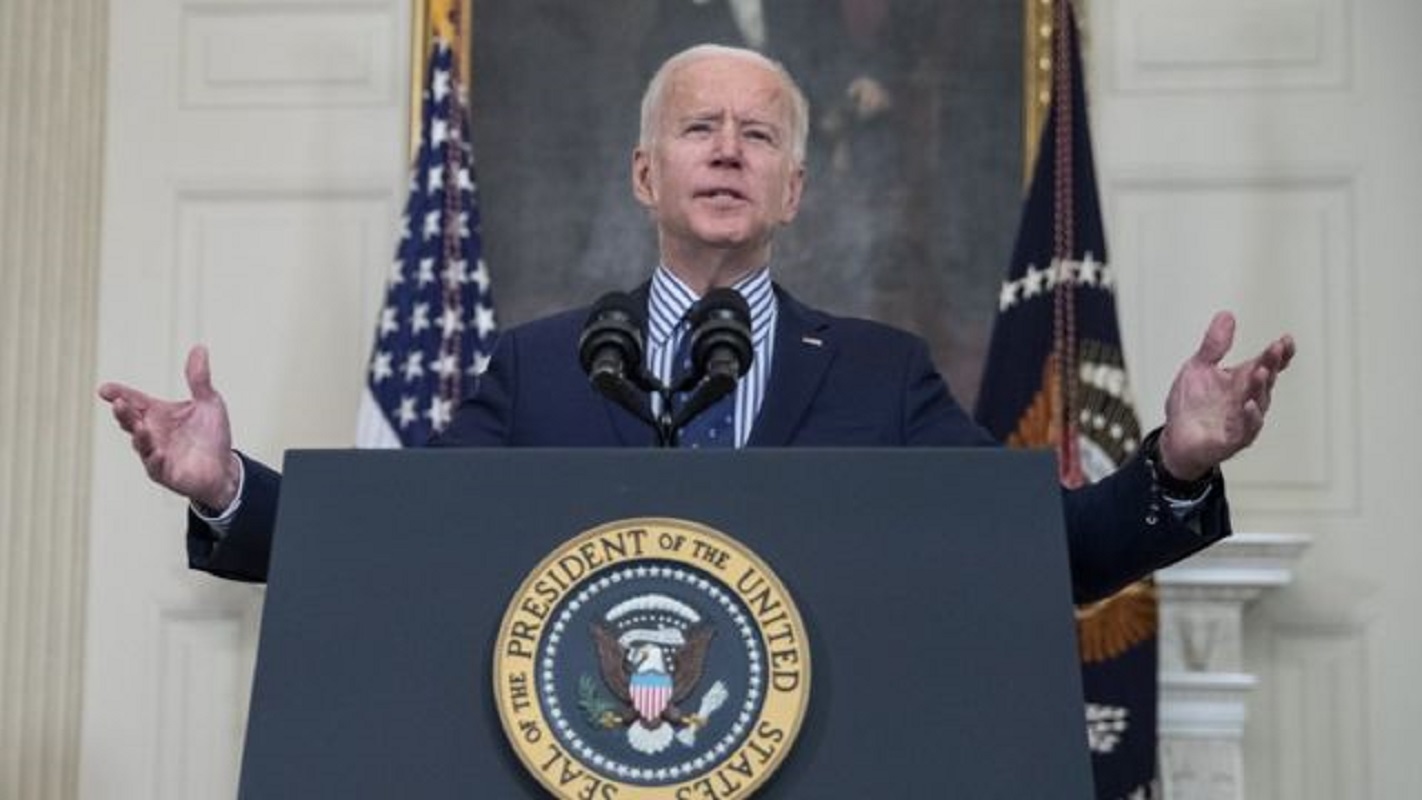In 2023, President of Ukraine Volodymyr Zelensky disclosed that the USA provided 34 military aid packages valued at over $24 billion. President Biden pledged an additional $61 billion in military and financial aid to our country in 2024. However, the US Republican Party, in Congress, is delaying approval, citing demands from the Democratic Party. Despite optimistic talks in Washington, Ukraine's military is facing a decline in capabilities, with reported ammunition shortages. The urgency of US Congress approval and contingency plans in the absence of aid are explored by Apostrophe.
No Magic Pot
Bidding for military aid to Ukraine in the US Congress between Democrats and Republicans has been going on since October. The country's internal state of shutdown, operating on a temporary budget, further impedes the allocation of military and financial aid to Ukraine for 2024.
On December 27, the USA declared the final military aid package for Ukraine in 2023, totaling $250 million. This marked the culmination of diminishing support, bringing an end to the assistance that had gradually waned.
We have now given Ukraine the last security assistance package that we have funds to support right be- — right before New Year’s, right after Christmas. And we’ve got to get support from Congress so we can continue to do that," John Kirby, US National Security Council Coordinator for Strategic Communications, said at a briefing.
He noted that after that, in the absence of additional funding, there is no other "magic pot" in which support for Ukraine could be found.
No Shells
Amid challenges in securing military aid from the United States, by the close of 2023, the Ukrainian military openly expressed concerns about insufficient artillery shells for deterring Russian aggression.
Brigadier General Oleksandr Tarnavskyi, the commander of the Tavria operational-strategic group, highlighted the pressing issue of artillery shells in an interview with Reuters.
‘There's a problem with ammunition, especially post-Soviet (shells) - that's 122 mm, 152 mm. And today these problems exist across the entire front line. The volumes that we have today are not sufficient for us today, given our needs,’ he said in an interview.
Notably, this development is expected. Military analyst Roman Svitan underscores that the prolonged Russian-Ukrainian war has strained Ukraine's production capacity, making it insufficient to meet all requirements.
As per the analyst, nations need decades to amass weapon stockpiles for war, yet these reserves may be depleted in a matter of months. With prolonged conflicts lasting years, virtually no country globally can sustain the effort solely relying on its own resources.
‘We must be objective; no military operates solely 'from wheels.' Even Russia, with a daily shell production of 5-7 thousand, faces shortages and resorts to purchasing from nations which are not engaged in this war,’ Svitan highlightes.
Former spokesperson of the General Staff of the Armed Forces of Ukraine and military expert Vladyslav Seleznyov observed a recent trend wherein military-technical support from Western allies to Ukraine has significantly decreased.
‘From August to October 2023, Ukraine experienced a 90% reduction in military and technical aid compared to the same period in 2022. The Ukrainian defense-industrial complex's capabilities fall short of meeting all the requirements of the Ukrainian Defense Forces,’ Seleznyov sais.
The expert clarified that the issue is not solely tied to the tumultuous developments in the USA.
‘This is also attributed to the global munitions-producing enterprises' failure to adapt to wartime standards. The ongoing conflict, the largest in scale on the European continent, places a substantial demand on resources,’ Seleznyov explaines.
Western analysts corroborate Seleznyov's statements.
‘We missed the moment when it was crucial to boost production,’ Rafael Los, an analyst from the European Council on Foreign Relations, remarked in an interview with ARD nearly a year ago. Importantly, this juncture preceded the large-scale invasion of Ukraine by Russia on February 24, 2022.
‘In prior years, military factories consistently downsized production capacity, as the post-Cold War era lacked a substantial market for large-caliber weapons. However, the shift occurred with Russia's assault on Ukraine in 2014, revealing a transformed landscape,’ the analyst noted.
The analyst contends that the issue could have been anticipated, but the opportunity to bolster military-industrial capacities was squandered.
However, German Chancellor Olaf Scholz has already urged European allies to intensify their efforts in providing military assistance to Ukraine.
Scholz stated that the German government has appealed to the European Union to clarify with individual member states the specifics of their planned supplies, as not all of them may be known.
The head of the German government expressed confidence that the EU will approve the proposed aid package of 50 billion euros for Ukraine at the emergency summit on February 1.
Plan B: Alternative and Drones
In January, if the US Congress remains deadlocked on Ukraine aid, Ukrainian authorities claim to have Plan B, referred to by National Security Council Secretary Oleksiy Danilov on New Year's Eve.
‘Regarding the performance of our defense-industrial complex, both state-owned and private entities have actively contributed to enhancing our country's defense capabilities since the start of the war. We have achieved notable milestones and are not falling behind. The weaponry we manufacture is garnering international astonishment,’ Danilov said.
As per his statement, the establishment of collaborative defense enterprises with partners is an ongoing process.
‘We are engaged in joint weapons production processes with partners in specific countries worldwide. This collaborative effort extends beyond a single nation, involving several countries where the joint manufacturing of essential components for victory on the front lines is underway,’ highlighted Danilov.
Oleksiy Melnyk, head of the Razumkov Center's security program, believes that plan "B" has already begun to be implemented.
‘In my view, Ukraine has transitioned to plan "B." We are adopting a defensive stance, conserving ammunition. This doesn't imply a complete absence of shells, hopeless situation; rather, it reflects a strategic decision to exercise restraint and conservation,’ as the expert highlighted in a commentary to Apostrophe.
Melnyk suggests that part of plan ‘B’ may involve exploring alternative sources for the procurement of projectiles.
‘Artillery shells stored in warehouses of US partner countries, such as South Korea, have been a source for supply. South Korea has facilitated the transfer of these shells to Ukraine. This operational scheme involves a 20,000-strong US military contingent stationed in South Korea, equipped with its own warehouses and weaponry. The process involves the utilization of projectiles with approaching expiration dates, which are then replaced with fresh supplies from US factories,’ Melnyk explaines.
However, challenges in the supply of shells from South Korea may arise. Russia is aware of this scheme and concentrates efforts to disrupt it.
Russia's strategic partner, North Korea, has been shelling the border waters of South Korea for several consecutive days, attempting to provoke the onset of a military conflict.
‘North Korea has consistently acted as a provocateur of instability, serving both its own interests and those of third parties. At present, there is a possibility that, at the behest of countries like China or Russia, North Korea could escalate regional confrontation to divert global attention from the ongoing war in Europe,’ political analyst Vitaliy Kulyk highlighted in a commentary to Apostrophe.
The expert suggests that the commencement of large-scale hostilities between North and South Korea would result in a restructuring of support from the United States and its allies.
‘This implies challenges not only in terms of finances but also in the logistical aspect of military goods supply. It's worth noting that South Korea played a significant role last year as a leading supplier of ammunition to Ukraine, handling logistics from third countries. Therefore, in the event of an active military phase, South Korea would understandably prioritize its own defense and resource replenishment, potentially impacting our expectations for support from partner countries of the United States in 2024 or 2025,’ Kulyk says.
Yet, as per the expert, the likelihood of a significant war on the Korean Peninsula in January 2024 is deemed low.
‘Another facet of plan "B" involves domestic production of ammunition and weapons, an area where Ukraine possesses considerable potential. While I don't have insight into military leadership plans, it's evident that we manufacture weapons, as illustrated by Russian missile strikes on our military-industrial complex facilities,’ Melnyk explains.
Certain experts posit that FPV drones could serve as an alternative to artillery shells. The head of the public relations service of the Ukrainian Armed Forces Ground Forces, Volodymyr Fityo, previously noted the effective use of FPV drones by Ukrainian soldiers against Russian invaders, deeming them a ‘heavenly punishment’ for the enemy. Additionally, President Zelensky mentioned in the December press conference that the production goal for 2024 is one million such drones.
No room for complacency
Despite the complexities in ammunition supply, there is hope that the military aid package from the United States for 2024 will be unlocked by Congress.
On January 8, a compromise was reached in the US Congress, leading to the approval of the government budget for 2024 and ending the shutdown. President Joe Biden urged Republicans in Congress to endorse additional funding for Ukraine.
Reports in the media are suggesting that the matter could be resolved later this week.
According to Senator James Lankford, the chief negotiator for the Republican Party, the parties are nearing an agreement on enhancing migration policies—a demand by Republicans in exchange for assistance to Kyiv.
‘In my view, there's no need for excessive concern. I am entirely confident that the Congress will approve aid to Ukraine,’ emphasized Oleksiy Melnyk.
Oleksandr Kovalenko, a military-political columnist with the "Information Resistance" group, shares this perspective.
I wouldn't be surprised if we witness another aid package from the USA for 2024 in the near future," the expert commented succinctly.
Oleksiy Melnyk advises journalists not to get ahead of themselves and wait for Congress's decision.
‘Nevertheless, Ukraine's leadership shouldn't remain passive; action is necessary. Even if the package is approved, a similar situation may arise in a year,’ summarized the expert.


